Index Matching Fluids
Definition: fluids with a refractive index similar to that of other optical materials, typically used for suppressing light reflections
Alternative term: refractive index fluids
German: Immersionsflüssigkeit
Categories: general optics, optical materials
How to cite the article; suggest additional literature
Author: Dr. Rüdiger Paschotta
Index matching fluids (sometimes also called refractive index fluids) are liquid substances which are selected or optimized such that their refractive index more or less matches that of some other optical materials. The more closely the refractive index is matched, the weaker are light reflections at the interface between the fluid and the other optical material. For normal incidence, the reflectivity of such an interface can be calculated with the following equation:

where n1 and n2 are the refractive indices of the two materials. Obviously, the reflection vanishes if the two refractive indices are equal.
More general relations for other angles of incidence can be derived from the Fresnel equations.
Example: Fabry–Pérot Effect at a Fiber Joint
As an example, consider an interface between two optical fibers, where the normally cleaved fiber ends are placed close together, but with a small gap between them. If that gap is filled with air, the substantial Fresnel reflections at the two glass–air interfaces form a Fabry–Pérot interferometers. That configuration exhibits reflection losses which for a given optical wavelength vary periodically with the gap width (as long as the gap is not too wide, so that beam divergence effects stay negligible). This can be seen in Figure 1.
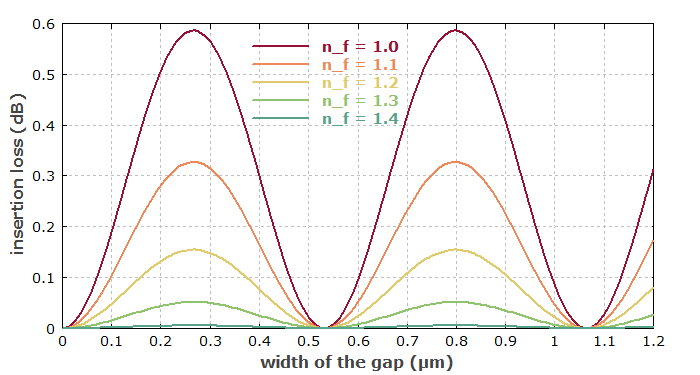
Available Fluids
Water is typically not usable as an index matching fluid, since its refractive index (≈1.333 at 589 nm) is substantially lower than that of most optical materials. For example, fused silica has an index of ≈1.458 at the same wavelength, and crown glasses have even substantially higher values. By solving some substances in water, the refractive index can be increased only to a limited extent. Further, water would evaporate too quickly for many applications.
For such reasons, other index matching fluids has been developed, which have higher refractive indices (mostly between 1.4 and 1.7) and evaporate much more slowly.
Some index matching fluids have a substantially higher viscosity, which can be convenient for applications. High-viscosity fluids are called index matching gels. An important practical advantage of using optical gels instead of low-viscosity fluids is that they stay at their place without special measures for encapsulation. However, liquids may be more convenient for short-term applications, e.g. for a proof of concept after which the components can be reused for other purposes.
Silicone-based fluids are often used with visible and near-ultraviolet light, because they are chemically quite inert, can be made with high purity and can be used in wide temperature ranges. Their refractive index and viscosity can be controlled to some degree via the chemical composition.
Some silicone-based matching fluids are curable, i.e., their viscosity can be strongly increased. They are delivered as two components which are mixed before heat. The curing can be accelerated with a heat treatment.
There are also optical component adhesives, which are initially liquid but can be completely solidified (usually by polymerization, which is induced thermally or by UV irradiation). For example, certain types of optical prisms (e.g. Wollaston and Nicol prisms) are made from two different prisms which are put together with such an index matching adhesive. For permanent applications, one usually prefers index matching materials which can be solidified and thus more long-term stable, not requiring any encapsulation.
Various other index matching fluids are commercially available, often without their chemical composition being revealed by the manufacturer. It may be difficult to judge which fluid is best suited for an application, or which other fluids may be used as satisfactory replacements. The available specifications are often not sufficiently precise for such purposes.
Index matching fluids are usually sold either in small bottles (with applicator caps) or in syringes. With the latter, they can be conveniently applied without exposing them to air before use. The content is often only a few milliliters, which however may last long in a laboratory, since normally one requires only quite small volumes.
Applications of Index Matching Fluids
Here are some examples for applications of index matching fluids:
- As shown above, parasitic reflections due to small air gaps can be virtually eliminated by filling such a gap was a suitable index matching fluid. For example, the performance of a mechanical fiber splice can be substantially improved with a tiny droplet of index matching fluid filling the gap between the fibers. However, this method is not very practical for non-permanent splices, since it is difficult to clean the fiber ends after removal from the splice; one may have to cleave them again.
- If an optical fiber is used where the coating has been stripped off, there is very little attenuation of cladding modes. If this is a problem, a droplet of index matching fluid somewhere on the fiber can induce strong attenuation of the cladding modes, since light can now easily leak out into the droplet and will mostly not find the way back into the cladding.
- Some high-resolution microscopes are operated with an immersion oil between the objective and the object under investigation. Such oils effectively increase the numerical aperture of the objective and in that way allow one to achieve a higher image resolution. Because such an immersion oil usually has a refractive index close to that of the glass material of the objective, it can also be regarded as an index matching fluid.
One may be tempted to mix different index matching fluids in order to obtain some intermediate value of the refractive index. However, this does not work for various combinations; for example, the mixture may not be optically homogeneous. Therefore, mixing should be done only as far as explicitly permitted by the manufacturer. An applicator cap must be used only for one specific substance.
Important Properties of Index Matching Fluids
Various properties of an index matching fluid can be relevant for applications:
- A primary performance figure is the refractive index at the optical wavelengths of interest. Various fluids have been developed for matching certain common optical materials like fused silica, BK7 or certain crown glasses. Depending on how strongly reflections must be suppressed, there is a larger or smaller tolerance for the refractive index. The fluids should be optically very homogeneous.
- There should not be any substantial absorption or scattering of light in the relevant wavelength region. This can be a challenge for infrared and ultraviolet applications. Suppliers should provide absorption spectra for the relevant wavelength regions.
- Such fluids should ideally not exhibit any significant rate of evaporation at the intended operation temperatures, and they should be chemically stable over long times. Ideally, they should also not react e.g. with metallic parts (causing corrosion) with which they may get into contact.
- Some degree of viscosity can be convenient for applications. If such a fluid exhibits good adhesion to optical surfaces (if they are sufficiently clean), it is easier to avoid any air bubbles.
- For temporary applications, it is often desirable that an index matching fluid can be completely removed from optical surfaces after use, restoring the full optical quality without cumbersome cleaning procedures. One will often require some solvent (e.g. isopropanol or acetone) – ideally, one which is easy to obtain and safe to use. Tentatively, low-viscosity fluids are easier to remove.
- Ideally, the used fluids are not flammable and non-toxic, thus completely safe to use.
Suppliers
The RP Photonics Buyer's Guide contains 4 suppliers for index matching fluids.
Questions and Comments from Users
Here you can submit questions and comments. As far as they get accepted by the author, they will appear above this paragraph together with the author’s answer. The author will decide on acceptance based on certain criteria. Essentially, the issue must be of sufficiently broad interest.
Please do not enter personal data here; we would otherwise delete it soon. (See also our privacy declaration.) If you wish to receive personal feedback or consultancy from the author, please contact him e.g. via e-mail.
By submitting the information, you give your consent to the potential publication of your inputs on our website according to our rules. (If you later retract your consent, we will delete those inputs.) As your inputs are first reviewed by the author, they may be published with some delay.
See also: refractive index, Fresnel equations
and other articles in the categories general optics, optical materials
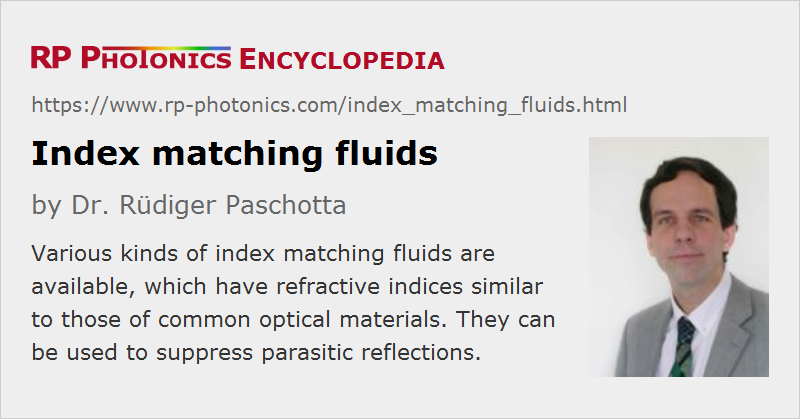 |




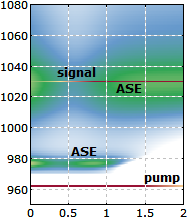


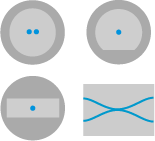

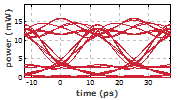
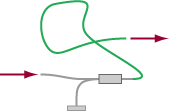

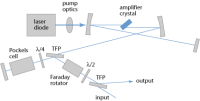

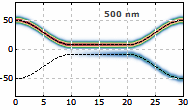
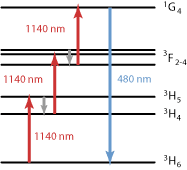










If you like this page, please share the link with your friends and colleagues, e.g. via social media:
These sharing buttons are implemented in a privacy-friendly way!